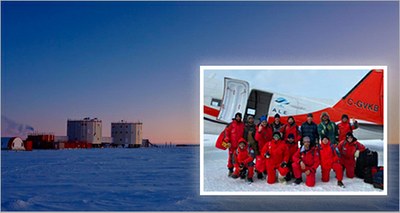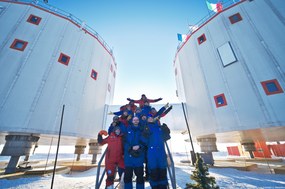Antarctica: "Change of season" in the two Italian bases
12/3/2020
The 35th summer campaign of the National Research Program in Antarctica (PNRA) ends, the 16th winter campaign at the Italian-French station "Concordia” begins
 The 16th winter campaign of the National Research Program in Antarctica (PNRA), funded by the Ministry of University and Research and implemented by the CNR for scientific planning and coordination and by ENEA for planning and logistical organization of shipments, has started at the Italian-French Station Concordia located on the Antarctic Plateau at a height of over 3000 m above sea.
The 16th winter campaign of the National Research Program in Antarctica (PNRA), funded by the Ministry of University and Research and implemented by the CNR for scientific planning and coordination and by ENEA for planning and logistical organization of shipments, has started at the Italian-French Station Concordia located on the Antarctic Plateau at a height of over 3000 m above sea.
For the next eight months, 12 people, 5 Italians from the PNRA, 6 French from the French Polar Institute "Paul Emile Victor" (IPEV) and 1 Dutch physician from the European Space Agency (ESA) will remain in total isolation to maintain the experimental equipment in operation and continue the ongoing research work of the French and Italian Antarctic programs, concerning studies of glaciology, chemistry and physics of the atmosphere, astrophysics, astronomy and geophysics. The projects of the European Space Agency (ESA) will continue as part of the scientific studies on human adaptation in extreme environments.
 In the meantime, the normal research activities of the 35th PNRA summer campaign at the Italian station "Mario Zucchelli", located on the promontory of Baia Terra Nova, ended. This year the only "all-Italian" base in Antarctica does not close its doors: for the first time, in fact, a group of 14 people will remain at the base until the end of March to carry out renovations of the base rooms. The team will return to New Zealand on April 8, aboard the Korean icebreaker "Araon".
In the meantime, the normal research activities of the 35th PNRA summer campaign at the Italian station "Mario Zucchelli", located on the promontory of Baia Terra Nova, ended. This year the only "all-Italian" base in Antarctica does not close its doors: for the first time, in fact, a group of 14 people will remain at the base until the end of March to carry out renovations of the base rooms. The team will return to New Zealand on April 8, aboard the Korean icebreaker "Araon".
During this summer campaign, research activities were conducted in various scientific fields, for a total of 42 projects concerning life sciences, the Earth, atmosphere and space. The data collected in Antarctica will be processed in the coming months at the Italian laboratories that took part in the projects.
Work on important infrastructures was carried out, such as that on the first airfield on land which, from mid-January to mid-February, was used for landings and departures of a light aircraft (Basler). During the summer campaign, 250 participants took turns, from both the scientific and logistic areas, of which 26 from the Italian Armed Forces: Operations Room operators and Army Alpine guides for the setting up of external fields; divers and naval raiders; staff for weather forecast and Air Force technicians; scuba divers of the Carabinieri force in support of scientific projects.
Intercontinental air transfers for the transport of people and materials from New Zealand to Antarctica were carried out by the Air Force. It was also the first year in the Ross Sea for the new Italian icebreaker "Laura Bassi" of the National Institute of Oceanography and Experimental Geophysics (OGS) which in two trips, in addition to logistical support, conducted an oceanographic campaign, reaching the southernmost point on Earth ever touched by an Italian ship.
![]()
